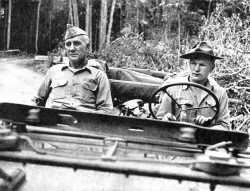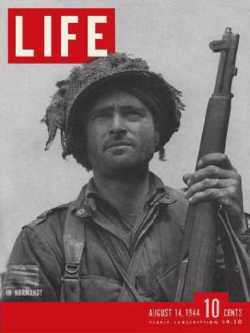THE LEDO ROAD
"PICK'S PIKE" FOLLOWS STILWELL'S ADVANCE IN BURMA
 When Lieut. General Joseph Stilwell opened his offensive in northern Burma last October,
the beginnings of a road were built behind him.
In command of the road builders was Brig. General Lewis A. Pick.
Said General Pick "I can keep up with Stilwell as fast as he can drive the Japs out of this area."
When Lieut. General Joseph Stilwell opened his offensive in northern Burma last October,
the beginnings of a road were built behind him.
In command of the road builders was Brig. General Lewis A. Pick.
Said General Pick "I can keep up with Stilwell as fast as he can drive the Japs out of this area."
Last week Stilwell's men finally pushed the Japanese out of the city of Myitkyina, where they had been stalled in drenching monsoon for 77 days. Before they had been delayed at Myitkyina, however, Stilwell's forces had made the most important Allied gains of the entire war in Asia. From their starting point of Ledo, in Assam, they had driven 290 miles overland, nearly cutting off the top of the great Japanese salient jutting up between China and India. General Pick had not quite been able to follow Stilwell into Myitkyina, but it was through no fault of his own. Myitkyina had been entered by a daring march over mountains and through Japanese lines. The road had to wait until the by-passed valleys had been cleared of the enemy.
By last week General Pick's men had finished the first 167 miles of the Ledo Road, from the railhead at Ledo
to Walawbum.
Now the road builders were completing a 77-mile stretch between Walawbum and Mogaung,
would soon be able to continue from Mogaung to Myitkyina, only 30 miles to the east.
From Myitkyina the road could take either of two routes into China.
 It could cut eastward to Yunnan Province through jagged mountains which rise above the Salween River.
Or, if the Japanese could be driven farther south, it could go southward through the valleys to Bhamo
and from there join with the old Burma Road.
Last week the Chinese fighting westward from the Salween made progress which promised to open at least one
of these routes.
They entered the big Japanese base of Teng-yueh, 65 miles southeast of Myitkyina,
had even sent patrols to within 26 miles of Stilwell's forces.
It could cut eastward to Yunnan Province through jagged mountains which rise above the Salween River.
Or, if the Japanese could be driven farther south, it could go southward through the valleys to Bhamo
and from there join with the old Burma Road.
Last week the Chinese fighting westward from the Salween made progress which promised to open at least one
of these routes.
They entered the big Japanese base of Teng-yueh, 65 miles southeast of Myitkyina,
had even sent patrols to within 26 miles of Stilwell's forces.
Although General Pick's pike logically sought the easiest available terrain, it was still a stupendous job of engineering. Almost at the outset it had to be lifted over 3,000-ft. Pangsau Pass. Farther along it had to be pushed through virgin jungle where no road had ever been before. One of the greatest of all problems in this waterlogged country was the drainage necessary to keep the road open through the rains, but Lewis Pick was well prepared for this kind of work. Before he came to the Ledo Road he had been division engineer on the temperamental Missouri River. There he devised the famous Pick Plan, a system of dams and reservoirs for flood control and irrigation which is must talked of in the Middle West.
When General Pick's road is finished, it will open the first southern land route to China since the Japanese cut the Burma Road. It is doubtful, however, whether it will then carry enough supplies to make possible a big drive by the Chinese. But at the very least the road is a firm, pulsating artery for Stilwell's operations. And Stilwell's nomination to a four-star generalship last week was an indication that a new offensive may not be far off.

AT MESSTIME ON ROAD a group of engineers talks with native laborer in the rain. At left, like a row of strange tropical plants, are other natives crouched beneath rain-capes. Rains of Burmese "Chota" monsoon (30 inches last June) have softened surface of road into layer of glutinous mud, but it is still passable to heavy traffic. One of General Pick's main objectives was to build road which could be used in all kinds of weather. Where original road traveled through soggy valley bottoms, new road was often re-routed to higher, drier ground.

CHINESE ENGINEERS build bridge out of massive jungle hardwood trees. This bridge, one of more than 700 between Ledo and Mogaung, crosses a small stream flowing into Tanai River about 135 miles southeast of Ledo. At this point the Ledo Road has crossed Pangsau Pass, greatest initial barrier, and continues down valleys toward Mogaung. General Pick's construction army includes a regiment of Chinese engineers. Other forces: U.S. Army engineers, native laborers. Most of natives were recruited from great British tea plantations in Assam.

TRUCK CONVOY moves through gasoline dump (left rear) at Loglai, 55 miles from Ledo railhead. All trucks are equipped with tire chains for traction in mud.

TRACTOR DRAGS HEAVY LOGS over road to scrape off mud. Man sitting next to operator cradles carbine in case sniper should try to pick them off from jungle. As Stilwell's forces pushed the Japanese down the moist valleys toward Mogaung, the road builders often worked within earshot of firing. Solid wall of jungle foliage borders the edge of the road.

IN MORASS OF MUD one jeep labors to pull out another mired up to the axles. Road passes through Hukawng-Mogaung Valley, where the jungle is thickest.

CHINESE SOLDIERS, part of crack U.S.-trained 22nd Division, pass truck convoy on road. Branches are tied to mule packs for partial camouflage from the air. Chinese 22nd, under command of Major General Liao Yao-Hsiang, took part in spring battles around Maingkwan, where Chinese and U.S. Marauders gave Japs worst beating of northern Burma campaign.

NEW ROAD, two lanes wide along this stretch, cuts straight through jungle toward hazy horizon. Narrow trail of old road may be faintly seen at right as it wanders among trees. Aerial pictures were made on a rare sunny day.

WINDING THROUGH JUNGLE, road is visible in dry weather as long, wooly cloud of dust. Trucks on the road are completely obscured. Closer to the battlefront, trucks would have to travel less than 10 mph to prevent enemy observation.

SHELL HOLES ALONG ROAD were made by Allied artillery when Japanese held town partly hidden in trees by river. Squares marked by hummocks are rice paddies. This is one of infrequent large clearings in north Burma.

CLIMBING OVER MOUNTAIN the road makes a hairpin turn. At bottom center trucks are parked next to gasoline depot. Inside curve is tent of road-control station. Old road curves tortuously farther down the slope.

ROADSIDE AIRSTRIP, one of at least six between Ledo and Mogaung, was made by road builders. Strips were cleared adjoining road for convenience in construction and gasoline supply. They are big enough for heavily laden transport planes.

ROAD ZIGZAGS in sweeping stages to climb over range of 4,000-ft. mountains. Inside upper big bend are long buildings of an Army camp. This and other settlements below were built on slope to escape oppressive heat and dampness of the valleys.
MUCH OF ROAD WORK IS DONE BY AMERICANS
The greater part of General Stilwell's force of northern Burma is made up of foreign troops, mostly Chinese, with a few Burmese, Indians, and British. General Pick's force, however, has a large body of Americans. Working on the Ledo Road are 9,000 U.S. Army engineers, many of them technicians. They work with a regiment of Chinese engineers and a minimum of 10,000 native laborers at one time.

(L-R) Pfc. Isaiah Smith, Fort Wayne, Indiana, drives truck; Cpl. J. Moran of Massachusetts, drives bulldozer; Cpl. Kenneth C. Atkins, Marion, N.C., truck driver

(L-R) Joe Greene of Jacksonville, Fla., bulldozer driver; Earlie Colbert from Georgia, operates bulldozer; Eugene Loring of Alto, La., drives grader

(L-R) Ernest Blount of Lake Forest, Fla., bulldozer driver; E. A. Nashlund of Portland, Ore., ambulance driver; Janet Schwertman, Newton, Mass., Red Cross worker

Pick's U.S. engineers are tough, hardy and experienced.
Many of them worked on Air Transport Command bases in the Hudson Bay area of Canada before they came to Burma.
Most of these agree that they prefer the frozen north to the sodden tropics.
Like most engineers they refer to themselves as "Hairy Ears," a name derived from a largely unprintable
engineers' song.
(The
Engineers have hairy ears; and live in caves and ditches. They bang
their jocks against the rocks; those hardy sons of bitches.)
In the picture at left, one of Pick's men stands by a sign outside "Hairy Ears Clinic" which list a few private American names for the alien diseases of the jungle.
Except for an excursion as photographer on the first B-29 raid on Japan, Bernard Hoffman has been working in
 the humid jungles of Burma for the last five months.
His latest pictures show the Ledo Road, "toughest road-building job Army engineers have ever known,
any time or anywhere."
the humid jungles of Burma for the last five months.
His latest pictures show the Ledo Road, "toughest road-building job Army engineers have ever known,
any time or anywhere."
In the picture at right, he is washing off the blood-sucking leeches that infest Burma in numbers enough to emaciate a man who falls from illness or injury.

LIFE'S COVER: The tough, haggard man on the cover is one of thousands who are winning the
battle for France. He is Lieut. Kelso C. Horne, of the U.S. airborne infantry. Men like Lieut.
Horne saw their hardest fighting on June 6, when many of them were landed behind German lines in
Normandy with parachute troops. In the great break-through in France, airborne troops are probably
being used as infantry shock troops.
Adapted for the internet from the August 14, 1944 issue.
Portions copyright 1944 Time, Inc.